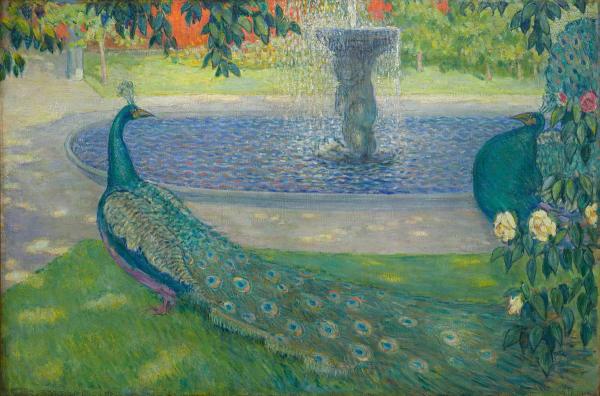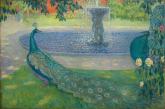Peacocks at a Fountain
Between 1911 and 1915
-
Location in museum
The Benois Wing,
Room 67
 Open the panorama of the hall in the virtual tour
Open the panorama of the hall in the virtual tour
- Period Early 20th century
- Animal Painting, Landscape
- Share
The paintings of the artist reflected the complicated searches of Russian art in the rough 1900s years. Alexander Gaush was closely connected to the artistic society “The World of Art”. As the members of society Konstantin Somov, Léon Bakst, Alexander Benois, he created in his works the world of beauty and harmony that whimsically comprised dream and reality and was full of the sense of the epoch and historical associations. The artist had widened the thematic scope of The World of Art landscape by his favourite motifs – landscapes of the beautiful gardens and parks transformed by the artist. Travelling to England (1911-1912) influenced the artist’s manner. The English countryside landscape became for the painter the real embodiment of his dream about the harmony of the world. Creating his own world, he had enriched his touch by the impressionist technique, from the searches for the light he had come to the searches for the colour, to highlighting of the decorative touch, and simplicity. The cool green and general light tone became with time the foundation of his specific palette and colours of his many works. The traditions of classical heritage of the 17th century French artists and art achievements of the early 20th century taking away in the beautiful world of artist's dreams are specifically interpreted in exquisite and elegant panels of Alexander Gaush.
Although Alexander Gaush was not an animalist, this particular work slots neatly into the artist's series of timeless views of English parks. An important “styleformative" element in Art Nouveau, the motif of the peacock was popular among artists from St Petersburg in the 1910s. Gaush's painting depicts the different characters of two birds. One is resplendent and important; the other is more modest, recognising its rival's supremacy. The combination of the stylised forms of Art Nouveau and Impressionist devices contributes to a refined whole. Gaush's aestheticisation of reality had parallels in the Acmeist poetry of the early 1910s.

